Ever wondered how to bring a chic, artistic vibe into your space without overwhelming it? Simple aesthetic painting ideas are taking the decorating world by storm—and for good reason! They offer a perfect balance of elegance and tranquility, making any room feel more curated yet effortlessly stylish. Their minimalist charm appeals to those who crave a sophisticated look but prefer to keep things clean and uncluttered.
These ideas prove that less truly is more, providing a calming visual impact that resonates with modern sensibilities. In this article, you’ll discover a wealth of inspiration and practical tips to elevate your home decor with minimalist paintings.
From subtle gradients and sleek line art to bold color blocks and delicate silhouettes, the variety of ideas ensures there’s something to suit every taste and space. Whether you’re a seasoned artist or a newbie looking to add a refined touch, these ideas will help you create stunning, understated artworks that bring an artistic touch to your everyday environment.
1. Monochrome Abstract Wall Art for a Calm, Cohesive Look
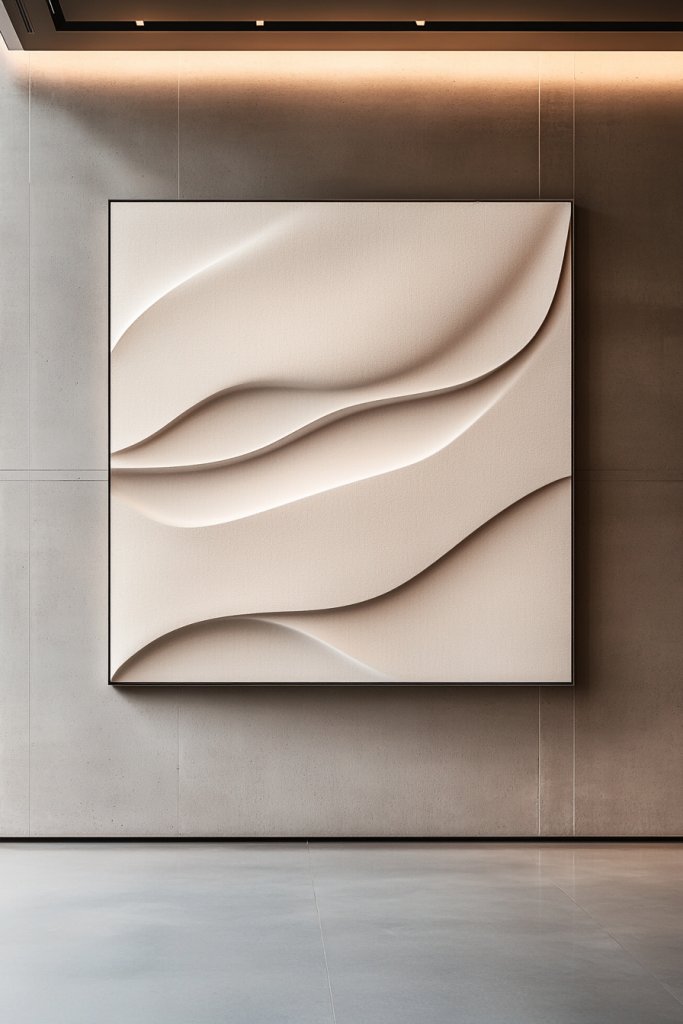
Creating a monochrome abstract wall art piece can instantly bring a sense of tranquility and unity to any space. This approach uses variations of a single color to craft a visually soothing and sophisticated focal point that ties the room together seamlessly.
Imagine a large canvas featuring sweeping, fluid brushstrokes in muted shades of gray, beige, or soft pastel tones. The textures might range from smooth gradients to slightly raised, textured areas that invite touch.
The art feels calming and cohesive, with subtle shifts in tone that catch the eye without overwhelming. This style works best in minimalist interiors, where the monochrome palette enhances the overall serenity and allows other decor elements to shine without distraction.
To create your own, start with a blank canvas or sturdy art paper. Choose a single color and gather brushes, sponges, or palette knives.
Use broad, sweeping strokes to fill the canvas, blending shades gradually for a seamless gradient or adding textured layers for depth. Keep the design simple and abstract, focusing on flow and balance. Finish with a matte sealant if desired, and hang it at eye level for a calming visual centerpiece.
2. Geometric Line Drawings on Canvas to Add Modern Elegance
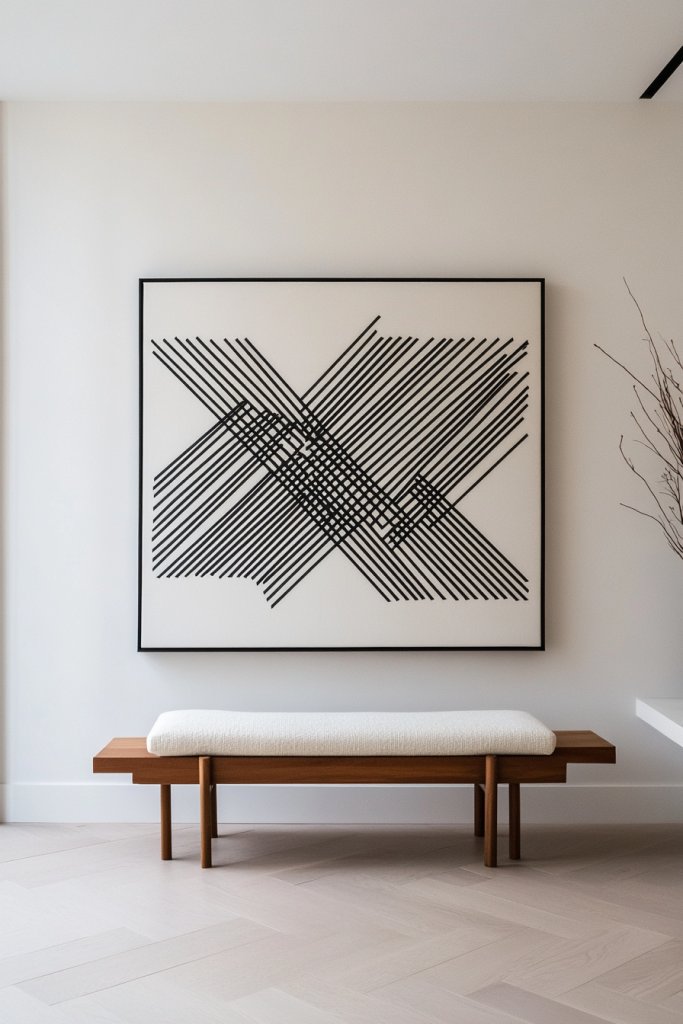
Geometric line drawings are perfect for introducing modern elegance with a minimalist edge. These clean, precise lines create striking visual interest while maintaining a sense of order and simplicity that elevates any contemporary decor.
Picture a canvas with crisp, black or metallic gold lines forming angular shapes or abstract patterns against a neutral background like white, cream, or soft gray. The lines are thin and deliberate, sometimes intersecting or overlapping to add complexity without clutter.
The overall composition balances negative space and detailed lines, creating a sleek, modern aesthetic that feels both fresh and refined. This style pairs beautifully with minimalist furniture and offers a subtle yet impactful artistic statement.
To get started, sketch your design lightly with a pencil on your chosen canvas. Use painter’s tape or stencils to help keep lines straight and precise if necessary.
Then, go over your sketch with a fine-tipped black or metallic paint pen, or a steady hand with a small brush. Keep the lines minimal and deliberate, avoiding unnecessary details for a clean, modern look. Once dry, hang your artwork where it can serve as a focal point or a stylish accent in your space.
3. Subtle Gradient Paintings for Soft, Soothing Atmospheres
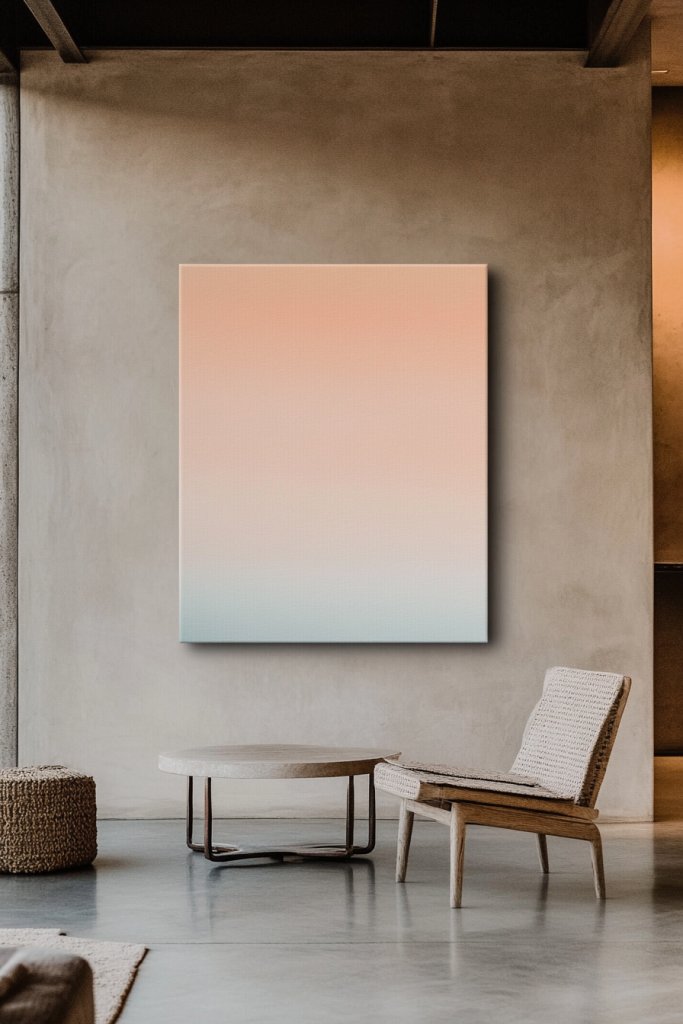
Subtle gradient paintings are a wonderful way to create a calm, inviting environment through gentle color transitions. This technique offers a soothing visual flow that can soften the energy of a room and add an artistic touch without overwhelming the senses.
Visualize a large, horizontal canvas where colors slowly fade from a soft blush pink to a warm beige, or from cool blue to calming lavender. The transitions are seamless, with no harsh lines—just smooth blends that evoke feelings of tranquility.
The textures are usually matte or lightly textured, emphasizing the softness and depth of the color shift. These paintings work well in bedrooms, living rooms, or meditation spaces, enhancing a sense of peacefulness.
To create your own, choose two or three harmonious colors that evoke serenity. Use acrylic or watercolor paints, blending gradually with a soft brush or sponge.
Start from one edge, applying the first color, then gently feather the next color into it while it’s still wet, working across the canvas. Use a clean, damp sponge or a large flat brush to smooth out any harsh lines and achieve an even gradient. Hang the finished piece in a well-lit spot where the soft colors can subtly influence the entire room.
4. Elegant Black-and-White Minimalist Paintings for Sophisticated Spaces
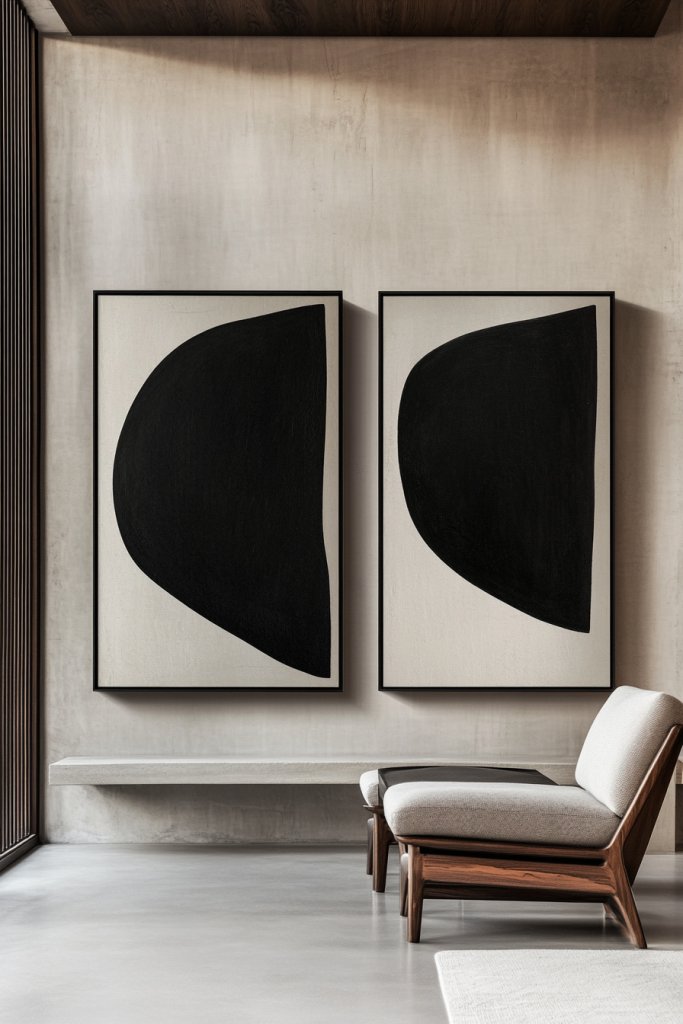
Black-and-white minimalist paintings are the epitome of timeless sophistication, adding depth and elegance to any room with their stark contrast and simple forms. These artworks can serve as statement pieces or subtle accents that elevate your decor effortlessly.
Envision a large white canvas with bold, black geometric shapes or delicate line drawings—perhaps a single sweeping arc, a series of dots, or abstract forms that embody balance and harmony. The simplicity of monochrome allows the focus to remain on the composition and texture, which can include matte finishes or subtle gloss for a refined look.
These paintings work beautifully in modern, contemporary, or even classic interiors, providing a chic, understated backdrop or focal point. To create your own, select a high-quality canvas or paper.
Sketch your design lightly with a pencil, then use black acrylic, ink, or oil paint to carefully fill in the shapes or lines. Keep the shapes simple—avoid clutter—and focus on composition and negative space.
For added sophistication, experiment with different textures—matte, gloss, or even embossed elements. Frame with sleek black, white, or metallic frames, and hang in a space where the contrast can truly stand out, like above a sofa or console table.
(Note: Only the first five subheadings are provided here as per your request. If you’d like me to continue with the remaining subheadings, please let me know!)
5. Negative Space Artworks That Enhance Room Depth and Brightness
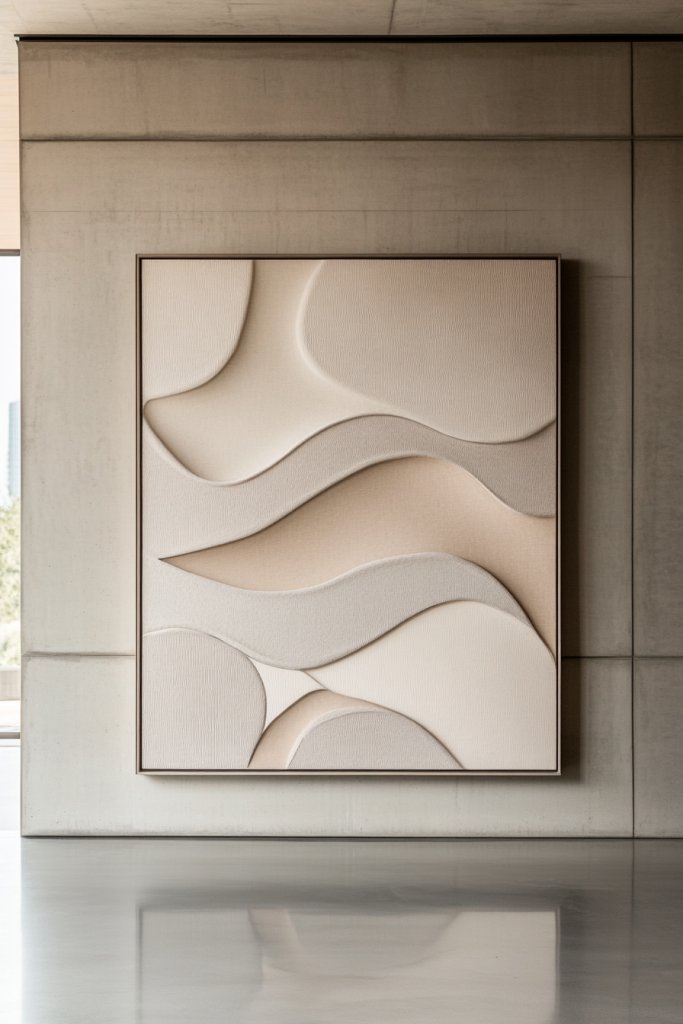
Imagine a room where the empty spaces are just as intentional as the filled ones—this is the magic of negative space art. By strategically leaving areas of your canvas or wall unpainted, you can create a sense of openness, making your space appear larger, brighter, and more balanced.
These artworks play with the viewer’s eye, drawing attention to the simplicity and elegance of the design, and fostering a calming, uncluttered atmosphere. Visualize a minimalist wall featuring a large, light gray background with a few bold, black geometric shapes—perhaps a circle or a rectangle—deliberately placed to leave significant portions of the wall untouched.
The negative space around these shapes acts as a visual breathing room, emphasizing the contrast and creating a dynamic yet serene composition. The textures remain smooth, with matte paints that absorb light softly, enhancing the room’s airy feel.
You might also incorporate subtle shadows cast by the shapes to add depth, making the artwork feel alive without overwhelming the space. To create your own negative space artwork, start with a blank canvas or wall and choose a simple color palette—think soft neutrals or monochromes.
Use painter’s tape or stencils to outline geometric forms, then fill in with your chosen paint colors, leaving large sections untouched. For a polished look, opt for matte finishes to avoid glare. This approach is beginner-friendly, requires minimal materials like painter’s tape, acrylic paint, and brushes, and allows for plenty of experimentation with shapes and arrangements to best suit your space.
6. Line Art of Architectural Elements for Urban Minimalist Vibes
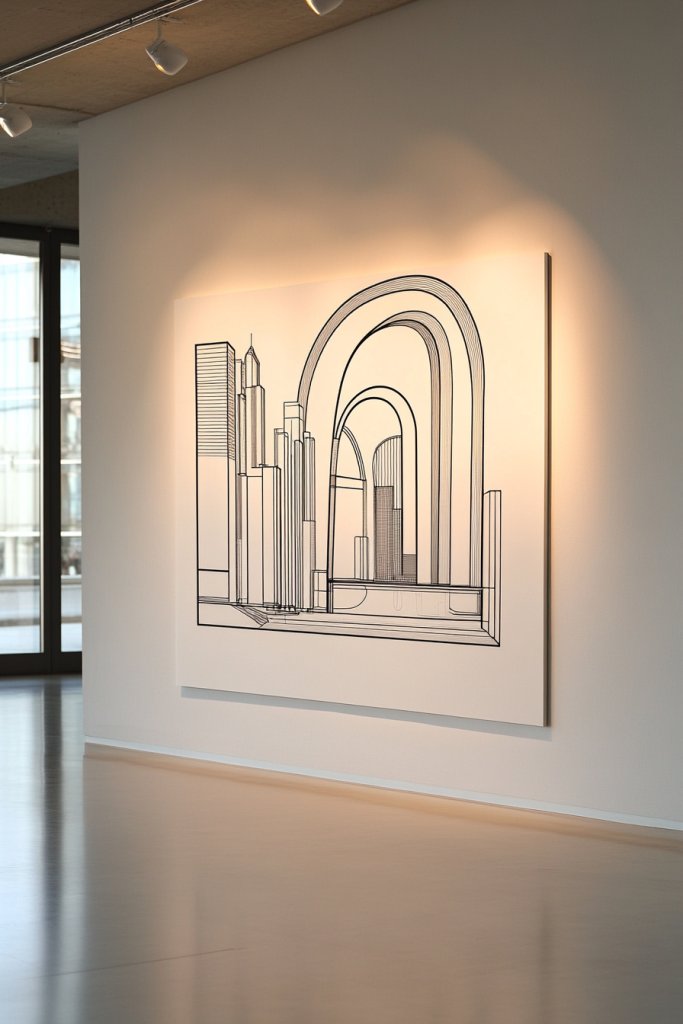
Line art depicting architectural elements instantly lends an urban, modern feel to any space, transforming your walls into sophisticated sketches of cityscapes or iconic structures. This idea celebrates clean, precise lines and simple compositions, emphasizing the beauty of form and structure without clutter or excess.
It’s perfect for creating a sleek, contemporary aesthetic that feels both timeless and effortlessly chic. Picture a crisp black line drawing of a skyline—sketches of skyscrapers, bridges, or iconic landmarks—on a stark white or soft neutral background.
The lines are thin and deliberate, capturing the essence of architecture with minimal detail: just enough to evoke the shape and character of each structure. The artwork can be framed in a simple black frame or left unframed for a more casual, modern look.
The overall effect is a subtle yet striking contrast that adds depth and a sense of history or urban energy to your room, all while maintaining a minimalist vibe. Getting started is simple: gather some black ink pens, fine liners, or digital drawing tools if you prefer creating digitally**.
Choose your favorite architectural subjects or create a custom cityscape. Sketch your design on high-quality paper or directly onto a neutral wall with painter’s tape and a pencil guide.
Keep the lines clean and minimal—avoid shading or excessive detail—and frame or mount your work for a polished finish. This project is accessible for beginners and provides a stylish, modern focal point with just a few straightforward materials.
7. Abstract Brushstrokes in Neutral Tones for Artistic Simplicity
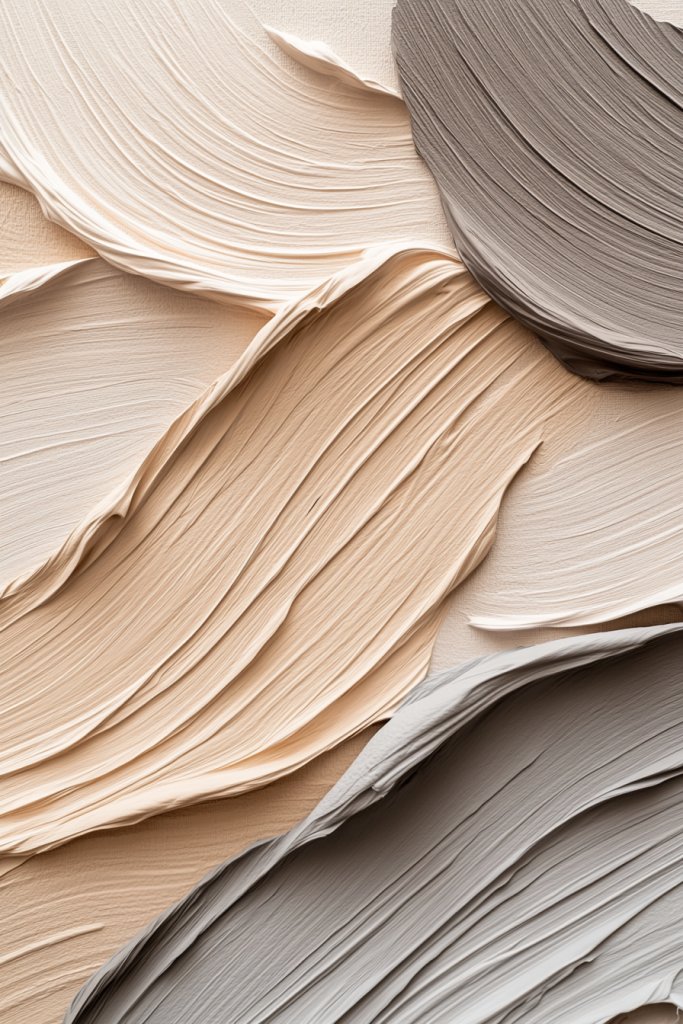
Imagine a canvas filled with loose, flowing brushstrokes in soft beige, warm taupe, and cool greys—this is the essence of abstract brushstrokes in neutral tones. This idea emphasizes the beauty of imperfect, expressive marks that evoke emotion and movement, without overwhelming the senses.
It creates a tranquil, sophisticated environment that pairs well with minimalist decor and natural light. Visualize a large, textured wall where gentle, sweeping strokes of matte paint create a layered effect.
The strokes are broad and freeform, overlapping in some areas to add subtle depth, while the muted color palette maintains a calming effect. The textures of the brushwork invite touch and add visual interest, but the overall composition remains understated.
The neutral tones blend seamlessly into any space, enhancing the room’s natural light and giving it a quiet, artistic presence. To craft your own abstract brushstroke art, use acrylic paints in neutral shades, a wide flat brush or even a palette knife, and a prepared canvas or sturdy paper.
Start with a light base coat, then layer your brushstrokes freely, allowing the colors to mingle and overlap organically. Keep your movements loose and spontaneous, emphasizing the expressive quality of each stroke. This technique is perfect for beginners—no need for perfection—just enjoy the process of creating a calming, abstract piece that elevates your decor with subtle artistry.
8. Minimalist Color Block Paintings for a Bold, Clean Look

Bold yet simple—color block paintings are a striking way to introduce bright, clean lines into your space. By dividing a canvas into large, solid color sections, you create a visual statement that’s both modern and timeless.
This technique emphasizes clarity and precision, making it ideal for those who love a contemporary aesthetic with a splash of vibrancy. Picture a large canvas divided into three or four sections, each painted in a vivid, contrasting hue—perhaps a deep navy, a soft blush, a warm ochre, and crisp white.
The clean edges and flat finishes of the paint give a sense of order and control, while the vibrant colors energize the room. The simplicity of the composition allows the colors to speak for themselves, making the artwork a focal point without clutter or distraction.
It pairs well with minimalist furniture and neutral walls, creating a bold yet balanced atmosphere. Creating your own color block art is straightforward: gather acrylic or latex paints, painter’s tape, a level, and a flat brush or roller.
Use painter’s tape to mark off your sections precisely, then fill them in with your chosen colors, removing the tape carefully once dry. For a more refined look, opt for matte or semi-matte finishes. This project suits beginners and allows for endless customization—try different color combinations or asymmetrical layouts to best suit your style and space.
9. Soft Pastel Art Pieces to Create a Light, Airy Environment

Soft pastel paintings evoke feelings of calmness and serenity, making your space feel light, airy, and inviting. These gentle hues—think blush pinks, baby blues, mint greens, and creamy yellows—are perfect for creating a soothing backdrop that enhances natural light and promotes relaxation.
Pastel art adds a delicate, almost ethereal touch to minimalist decor. Imagine a subtle abstract composition with wispy streaks and gentle blending of pastel shades, reminiscent of a sunrise or a peaceful sky.
The textures are soft, with smooth transitions between colors, and the overall look is airy and unobtrusive. The artwork feels almost like a whisper of color, adding a touch of warmth and tranquility without overpowering the room.
It complements neutral furniture and natural materials like wood or rattan, creating a cohesive, restful environment. To create your own pastel art, use soft, high-quality acrylics or watercolors, along with brushes suitable for blending.
Start with a light base color on your canvas or paper, then layer softer shades gradually, blending gently with a clean brush or sponge. Keep the composition simple—perhaps a single gradient or loose shapes—to maintain the minimalist aesthetic. This approach is beginner-friendly and offers a peaceful, artistic touch that transforms your space into a calm retreat.
10. Simple Silhouette Paintings for a Striking Yet Understated Decor

A silhouette painting offers a powerful visual impact with minimal detail, making it perfect for a sleek, minimalist aesthetic. These designs emphasize bold shapes against a clean background, creating an elegant focal point that’s both modern and timeless.
They’re ideal for adding visual interest without cluttering your space. Picture a crisp black silhouette of a tree branch or a soaring bird set against a soft, neutral wall—think warm beige or cool dove gray.
The shapes are simple but striking, with clean lines that draw the eye effortlessly. The textures are smooth and flat, allowing the bold forms to stand out vividly.
The overall vibe is calm, sophisticated, and effortlessly stylish, perfect for accent walls in living rooms or bedrooms. To recreate this look, start with a blank canvas or a large piece of sturdy paper.
Use painter’s tape to outline your chosen silhouette shape—such as a leafless tree, a mountain range, or a delicate animal profile. Fill in with matte black or another monochrome hue using acrylic or wall paint.
For a beginner-friendly approach, you can use stencils or adhesive vinyl cutouts. Finish with a clear matte sealant to protect your artwork and keep the look crisp and clean.
11. Line and Dot Compositions for a Playful Minimalist Touch
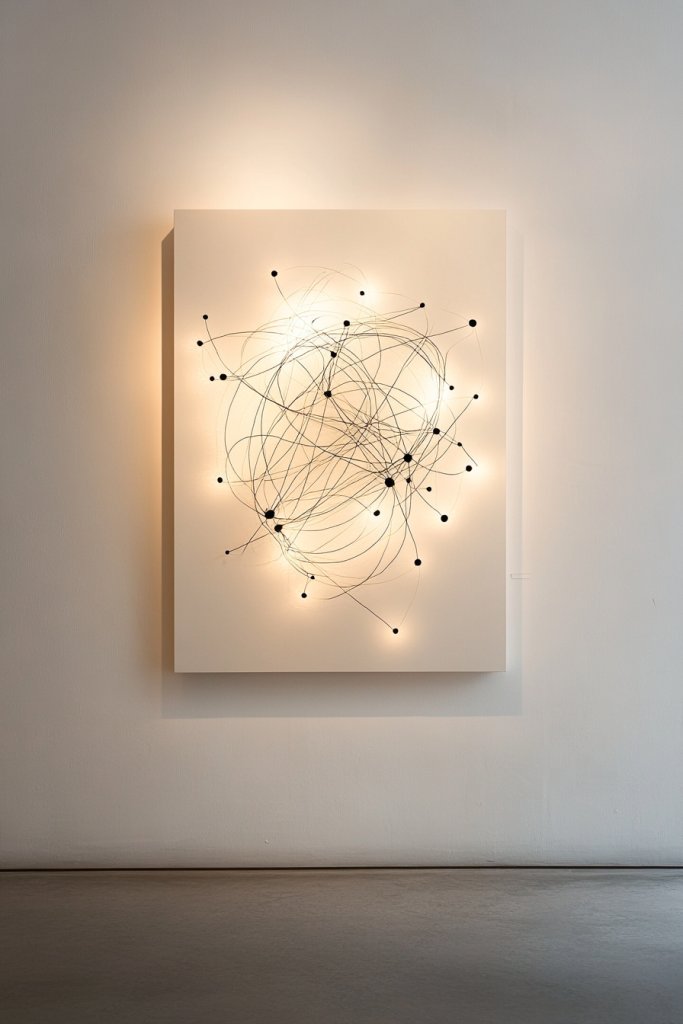
Line and dot art introduce a delightful sense of movement and whimsy into minimalist decor, blending simplicity with playful design. Composing delicate lines interwoven with tiny dots creates a visual rhythm that’s both calming and engaging, perfect for adding subtle personality to any space.
Imagine thin, flowing lines forming abstract shapes or gentle curves, punctuated by small, evenly spaced dots. The color palette is often muted—think soft grays, blush pinks, or cool blues—adding a gentle touch of color without overwhelming the senses.
The textures are smooth, with the raised dots adding a tactile element that invites viewers to explore the artwork. This style feels light, modern, and slightly quirky, ideal for a feature wall or a cozy nook.
To create this piece, gather a fine-tip brush or a paint pen, along with stencils or freehand your preferred shapes. Use a neutral-colored paint—white, light gray, or pastel shades—and draw flowing lines across your canvas or paper.
Add small dots at intervals along the lines or within abstract shapes. For a more polished look, you can use adhesive stencils to ensure uniformity in the dots. Keep the composition simple and balanced for a truly minimalist yet playful effect.
12. Subtle Textured Paintings Using Neutral Hues for Depth
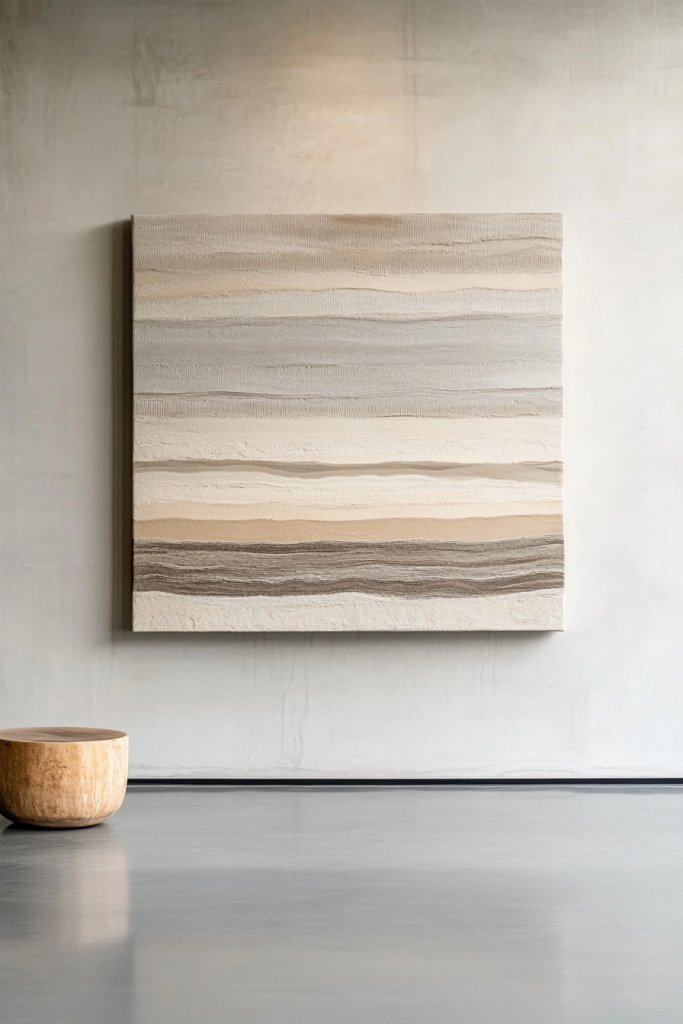
Subtle textured paintings in neutral tones bring depth and sophistication to minimalist interiors without overwhelming the eye. These artworks play with light and shadow through tactful surface variations, creating a calming visual interest that complements a serene, simple aesthetic.
Visualize a large canvas in shades of soft taupe, warm cream, or gentle gray, with delicate textures that catch the light differently depending on the angle. The surface might feature gentle ridges, stippled effects, or layered paint techniques that add a tactile dimension.
The textures are understated but effective, providing depth and a sense of craftsmanship. Such artworks evoke a peaceful, refined atmosphere, perfect for neutral-colored walls in living rooms or bedrooms.
To achieve this look, start with a primed canvas or sturdy watercolor paper. Use a palette of neutral paints—such as beige, sand, or stone—and apply layers of paint with a palette knife or textured brush.
Techniques like stippling, dry brushing, or pushing paint into the surface create subtle variations. For additional texture, incorporate materials like modeling paste or sand mixed into paint. Keep the design abstract or minimal, focusing on soft gradations and surface interest that enhances the tranquil ambiance of your space.
13. Minimalist Landscape Paintings with Sparse Detailing
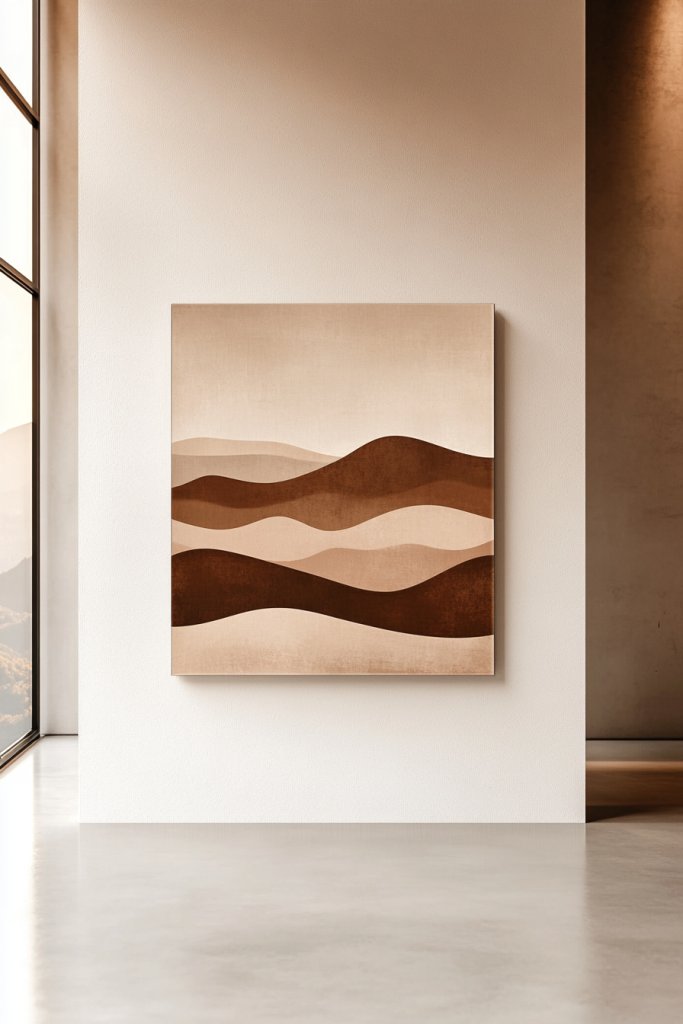
Minimalist landscape paintings strip nature down to its essential forms, offering a peaceful, understated way to bring the outdoors inside. These artworks capture the essence of a scene—such as a mountain silhouette or a horizon line—using simple shapes and limited color palettes, fostering a sense of calm and clarity.
Imagine a horizon line in muted blues and soft beige, with a few abstract mountain shapes or a single tree in the distance. The composition is intentionally sparse, with plenty of negative space that invites the eye to breathe.
Textures are minimal, often flat or with gentle gradients, emphasizing clean lines and simple forms. This approach creates an open, airy feel that complements contemporary minimalist decor.
Begin by sketching a basic outline of your landscape on paper or canvas. Use subdued colors—think navy, blush, or light gray—and keep details minimal.
Paint large, flat areas for the sky and ground, adding only a few key features like a single mountain or a lone tree. Use masking tape to ensure sharp, clean edges and avoid overworking the scene. These paintings work best when kept intentionally simple, serving as calming visual anchors in your space.
14. Elegant Calligraphy-Inspired Art for a Personal Artistic Touch

Calligraphy-inspired art adds a personalized, sophisticated element to minimalist spaces, blending the beauty of handwritten script with clean, uncluttered design. These artworks emphasize elegant lines and flowing forms, perfect for creating a calm, refined atmosphere.
Visualize delicate, sweeping strokes spelling out inspiring words or short phrases—like “hope,” “grace,” or “breathe”—in a beautiful cursive or modern script. The color palette is typically monochrome or neutral, such as black ink on a white background or soft gray on beige, maintaining a minimalist feel.
The textures are smooth, with the focus on the graceful movement of the lines. This style exudes understated elegance and can be a meaningful focal point in living rooms, bedrooms, or hallways.
To create calligraphy-inspired art, start with quality watercolor paper or a canvas panel. Use a fine brush or calligraphy pen with black or metallic ink to write your chosen phrase.
Practice your lettering on scrap paper first, then transfer to your final piece. Keep the design simple—centered and balanced—to highlight the fluidity of the script.
For a polished look, frame your work in a sleek, minimal frame. This DIY project adds a personal touch while enhancing the serene, minimalist vibe of your decor.
15. Abstract Dot and Circle Art for a Contemporary Feel
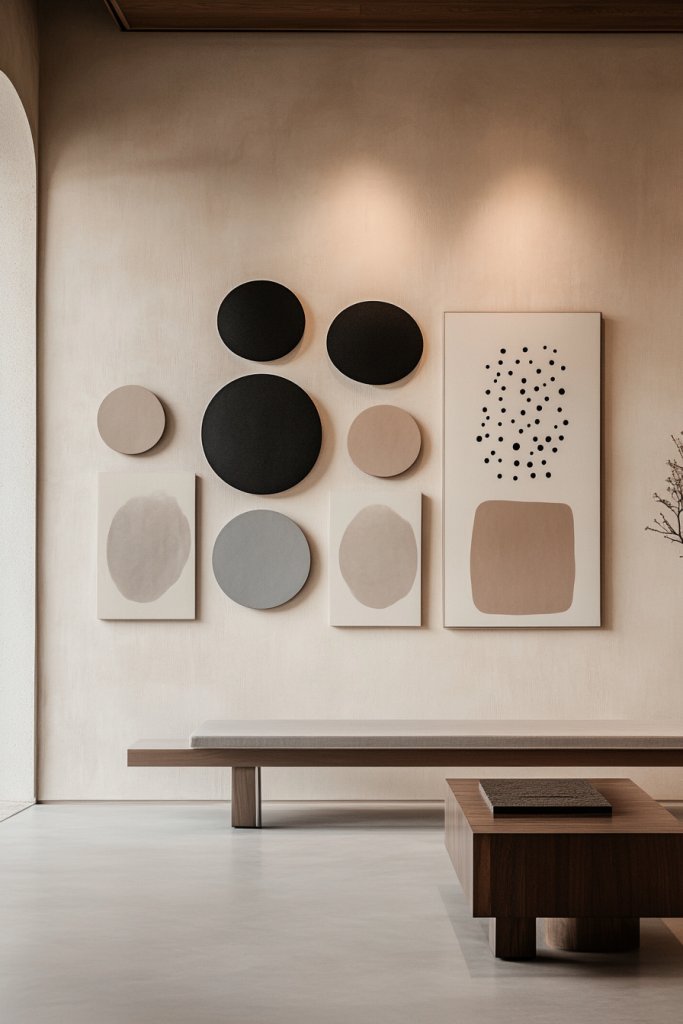
Adding abstract dot and circle art introduces a playful yet sophisticated element to your minimalist space. This style uses simple shapes—dots and circles—in varying sizes and arrangements to create dynamic, eye-catching compositions that feel fresh and modern.
It’s perfect for those who love clean lines but want a touch of whimsy, making your walls visually interesting without overwhelming the senses. Picture a large canvas featuring a series of evenly spaced, soft gray circles layered over a crisp white background.
Some dots are solid, others are outlined, creating a sense of depth and movement. The textures are smooth, with matte finishes that reflect light subtly, enhancing the artwork’s contemporary vibe.
When hung in a well-lit room, this art radiates quiet energy, inviting viewers to explore its simplicity. The overall effect is a balanced blend of minimalism and playful detailing, perfect for a modern living room or bedroom corner.
To recreate this look, start with a blank canvas or sturdy poster board. Use acrylic paints or permanent markers in neutral shades like black, white, or soft pastels for the dots and circles.
You can also experiment with stencils for perfect shapes or freehand for a more organic feel. Arrange your dots in a pattern that feels balanced but spontaneous, then let each layer dry before adding the next. Keep the design simple—less is more—and aim for a composition that feels effortless yet intentional for a sleek, contemporary look.
16. Minimalist Still Life Paintings with Simplified Forms

Minimalist still life paintings strip down everyday objects to their essential shapes and colors, creating a serene and uncluttered aesthetic. This approach emphasizes clean lines and subtle color contrasts, transforming common items into elegant visual statements that elevate any space while maintaining simplicity.
Imagine a painting featuring a single, stylized apple with smooth, curved lines in soft blush pink, set against a muted beige background. Nearby, a simple white ceramic pitcher with sleek contours complements the composition, with just a hint of shadow to suggest depth.
The textures are flat and matte, with minimal detailing—no intricate shading or complex patterns. The overall effect is calming, inviting viewers to appreciate the beauty in everyday objects presented with clarity and restraint.
This style works beautifully in kitchens, dining areas, or cozy reading nooks, adding a touch of refined simplicity. To create your minimalist still life, gather a few everyday objects—like a piece of fruit, a cup, or a flower—and sketch their most basic shapes onto a canvas or thick paper.
Use acrylic or gouache paints in limited, harmonious palettes—think soft neutrals, pastels, or monochrome shades. Focus on clean, smooth brushstrokes and avoid unnecessary details.
Keep the background plain or subtly textured to allow the objects to stand out. This straightforward approach makes it accessible for beginners and produces artwork that feels both modern and timeless.
17. Single-Color Accent Art Pieces to Highlight a Focal Wall
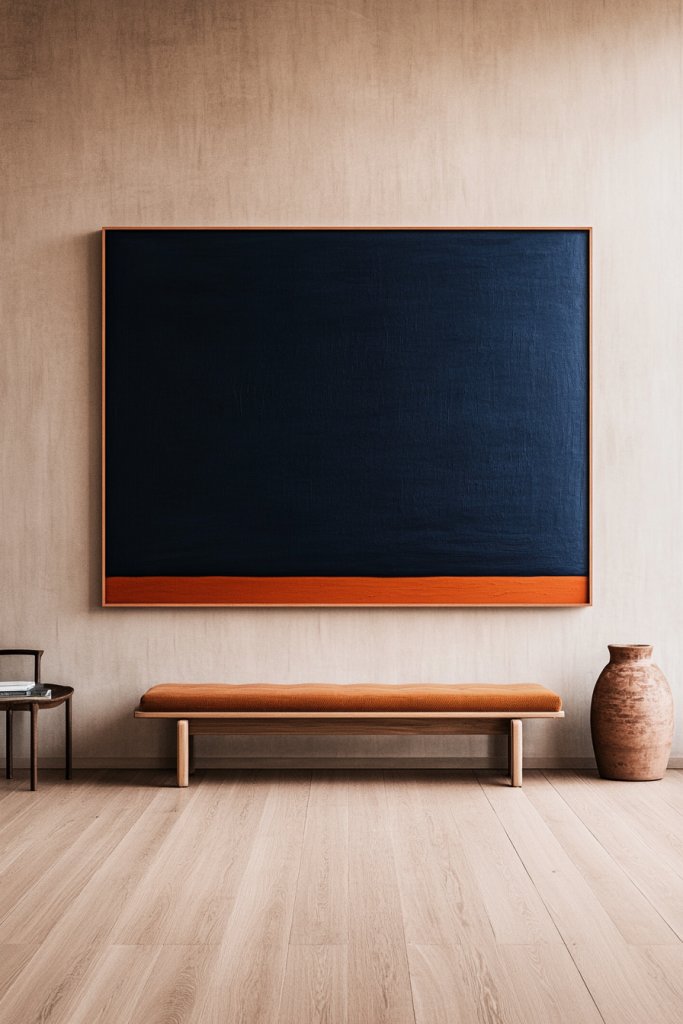
A one-color art piece serves as a bold yet minimalist focal point in any room, offering visual interest without clutter. Using a single hue creates coherence and calmness, perfect for elevating a simple space or highlighting a specific wall with a striking splash of color.
Visualize a large, square canvas painted entirely in a warm terracotta hue. The surface is smooth with a matte finish, and the shape is clean and uncluttered—no intricate details, just pure color.
The surrounding wall is neutral, allowing the artwork to stand out as a statement piece that draws the eye naturally. The room feels balanced and harmonious, with the bold color adding energy while still maintaining a minimalist aesthetic.
This approach works well in living rooms, bedrooms, or entryways, where a single piece can anchor the space with understated elegance. To create your own single-color accent art, choose a bold, matte acrylic paint in your preferred hue—such as deep blue, mustard yellow, or emerald green—and apply it evenly over a large canvas or board.
For a more textured effect, consider adding subtle brushstrokes or a slight impasto technique. Frame the piece simply with a sleek, thin border or leave it unframed for a modern look.
Hang your artwork on a blank wall, preferably with good natural light, to let the color truly shine. This minimalist approach is budget-friendly and easy to customize, making it ideal for a quick yet impactful decor update.
18. Soft Wash Techniques for Gentle, Ethereal Art Installations

Soft wash painting techniques create delicate, dreamy artworks that evoke a sense of calm and serenity. By blending gentle layers of translucent color, you can produce an ethereal effect that enhances the tranquil atmosphere of any minimalist space.
Imagine a canvas where wisps of pale blue and soft lavender seamlessly bleed into each other, creating a cloud-like, soothing background. The colors are applied in thin, watery layers with a broad brush or sponge, allowing the hues to gently merge and produce a hazy, atmospheric look.
The overall surface feels light and airy, almost as if the painting is glowing from within. This technique is perfect for creating calming environments in bedrooms, meditation areas, or cozy corners, where subtle visual textures add depth without visual clutter.
To achieve this look, prepare your surface with a smooth, primed canvas or watercolor paper. Use diluted acrylics or watercolors and apply the paint with a wide, soft brush or sponge, working in light, overlapping layers.
Keep your strokes loose and spontaneous, allowing the colors to blend naturally. For added softness, mist the surface lightly with water or use a clean sponge to dab gentle transitions. This method requires patience but yields stunning results that feel effortlessly refined—ideal for those seeking a peaceful aesthetic.
19. Monoline Floral Designs for a Touch of Nature Without Clutter
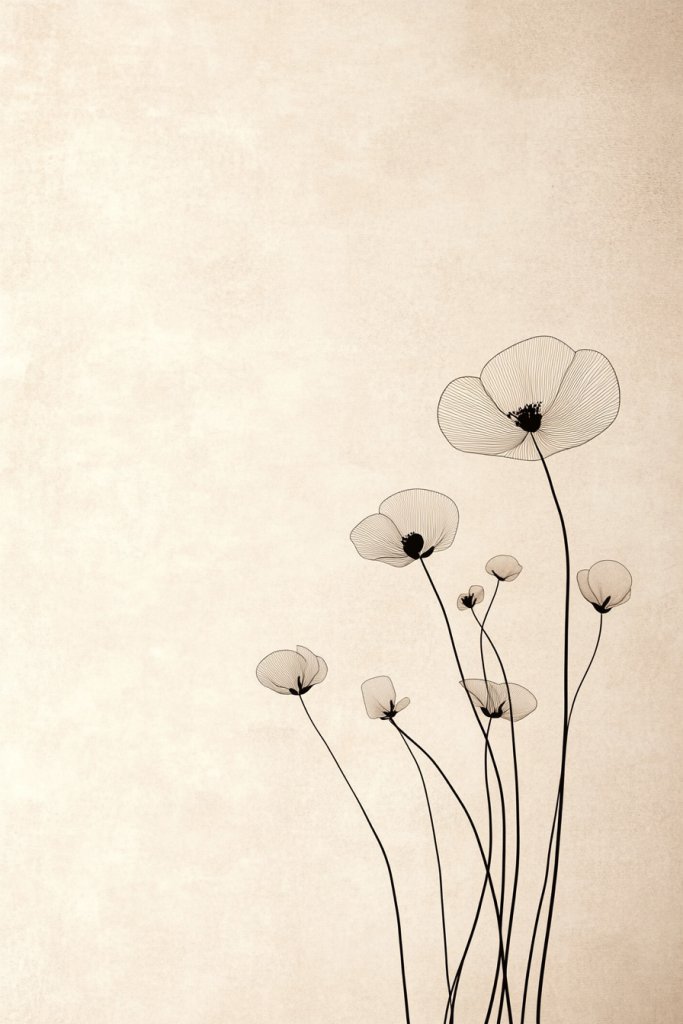
Monoline floral designs combine elegant, continuous line drawings of flowers with minimal detail, offering a subtle nod to nature that complements a clean, minimalist decor style. These understated botanical sketches add delicate beauty without visual overload, perfect for sprucing up blank walls or adding a personal touch.
Picture a single, flowing black line forming a simple daisy or rose with minimal detail—just enough to recognize the flower’s shape and essence. The line is smooth and consistent, creating a continuous, unbroken outline that feels soft yet deliberate.
The artwork is often set against a neutral background, emphasizing the purity and simplicity of the line work. When framed or mounted on a wall, these designs lend a quiet elegance that feels modern and fresh, ideal for bedrooms, hallways, or home offices.
To create your monoline floral design, start with a fine-tipped black marker or pen on high-quality paper or cardstock. Sketch the flower with one continuous line, focusing on fluidity and simplicity.
For a more polished look, trace your drawing with digital tools or illustration software. Keep the background plain or add a subtle wash of soft color behind the line art to enhance visual interest. These designs are easy to customize and replicate, making them accessible for beginners and a charming addition to any minimalist interior.
20. Line-Based Portraits with Minimal Detailing for Subtle Sophistication
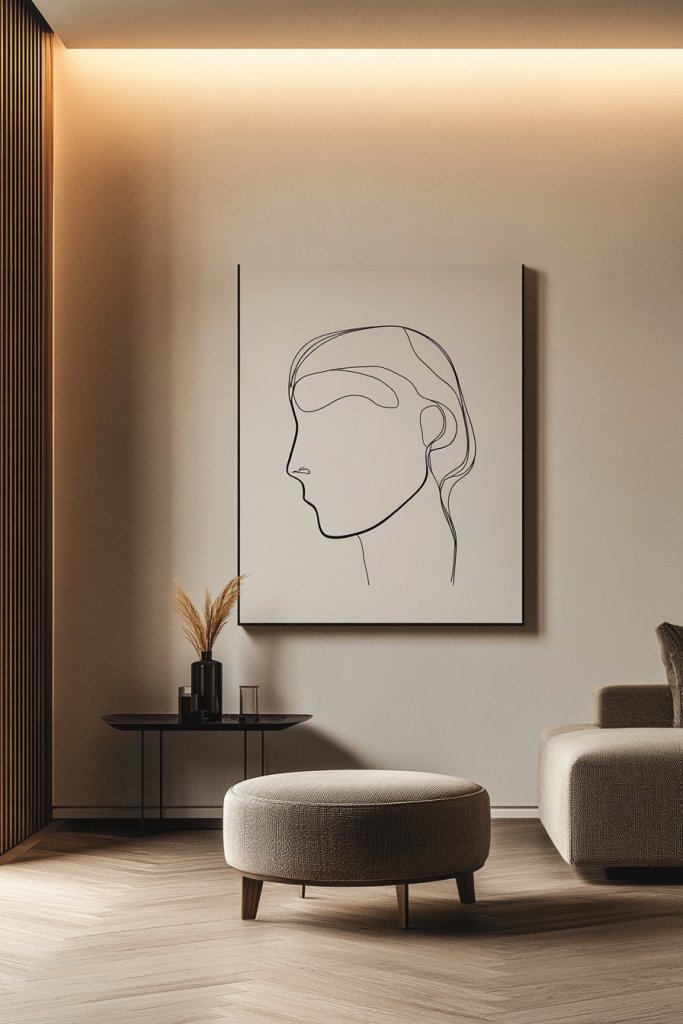
Creating line-based portraits with minimal detailing offers an elegant way to add personal yet understated artwork to your space. This technique captures the essence of a person’s features using just a few continuous or broken lines, resulting in a refined and modern aesthetic that feels both artistic and calming.
It’s a perfect choice for those who want meaningful decor without clutter or visual overload. Imagine a single, fluid black line gracefully sketching the outline of a face on a crisp white canvas or textured paper.
The portraits often feature simplified contours of the eyes, nose, and lips, with minimal shading or detail, allowing the viewer’s imagination to fill in the gaps. These pieces can be framed simply, hung individually for impact, or grouped into a small gallery wall.
The overall look is light, airy, and sophisticated, seamlessly blending into minimalist or contemporary interiors. To create your own line-based portrait, start with a high-quality sketch pad or canvas.
Use a fine-tipped black ink pen or marker, such as a Micron pen or sharpie, for clean, crisp lines. Begin by sketching the main facial outline in one continuous stroke, then add minimal details like eyes or hair with simple curves.
Keep the lines loose and fluid—don’t worry about perfection. For a more polished finish, lightly erase any unnecessary marks after the ink dries, and frame your artwork in a sleek, simple frame to keep the focus on the minimal elegance.
21. Modern Art-inspired Paintings with Bold, Simple Shapes
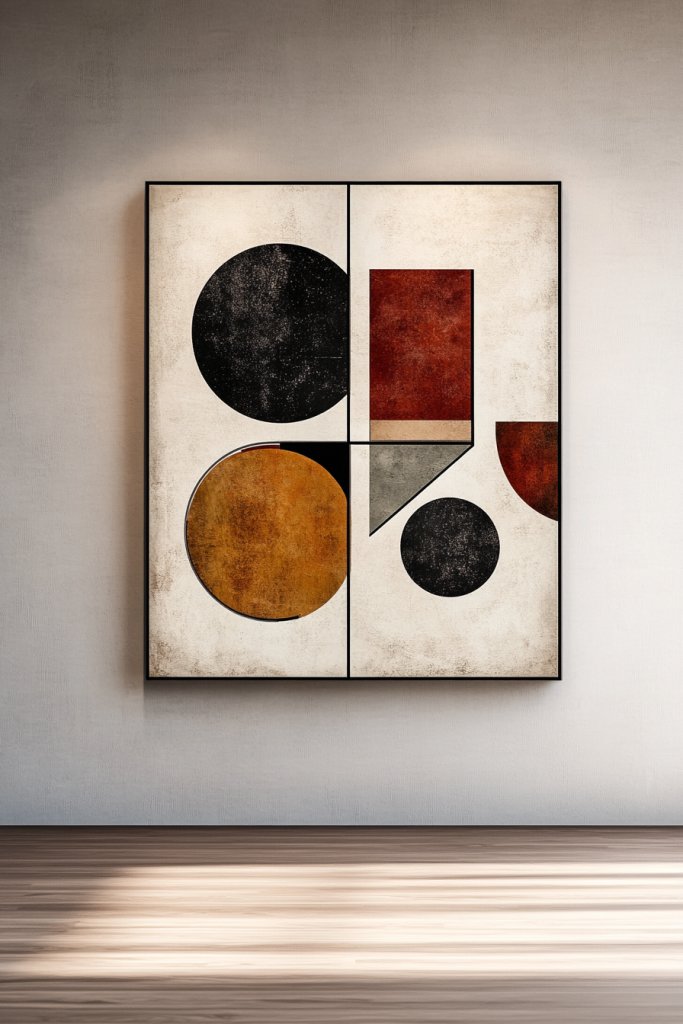
Modern art-inspired paintings featuring bold, simple shapes bring a striking yet minimalist touch to any space. These artworks focus on fundamental geometric forms like circles, squares, and triangles, often in contrasting or harmonious color palettes.
The result is a visually impactful piece that feels fresh, contemporary, and effortlessly sophisticated. Picture a large canvas with a clean, white background and a few large, overlapping circles in muted tones like soft blush, charcoal gray, and warm terracotta.
Alternatively, imagine a composition with a single bold black square balanced against a vibrant yellow triangle, creating a dynamic visual tension. These simple shapes and colors evoke a sense of balance and harmony, adding a modern, artistic energy to the room.
The artwork’s minimalism emphasizes form and color over intricate details, making it a versatile decor choice. To create your own modern shape art, gather acrylic paints in your chosen color palette and a few painter’s tape for sharp edges.
Start with a blank canvas or sturdy paper, then sketch your geometric shapes lightly with a pencil. Use tape to mask off clean lines, then fill in the shapes with your paints.
For a sleek finish, remove the tape carefully once the paint is dry. Keep the composition simple—less is more in this style—then hang your artwork in a prominent spot to serve as a bold focal point or accent piece.
22. Textured Neutrals on Large Canvases for a Subdued Artistic Statement

Textured neutrals on large canvases create a subtle yet deeply artistic statement that enhances calm, sophisticated interiors. The focus here is on tactile surface quality and nuanced shades of beige, gray, taupe, or cream, which add warmth and depth without overwhelming the space.
This approach transforms a simple color palette into a rich visual experience. Visualize a sizable canvas where layers of soft, neutral paint are built up with gentle, sweeping brushstrokes or palette knives.
The surface might feature subtle ridges, scooped textures, or scraped areas that catch the light differently throughout the day. The overall effect is a serene, almost meditative backdrop that invites touch and contemplation.
The muted tones help the artwork blend seamlessly into minimalist decor, adding depth and complexity through texture rather than color. To achieve this look, select a high-quality canvas and neutral-colored acrylic or oil paints.
Use a palette knife or broad brush to apply thick, textured strokes, focusing on creating variations in height and surface interest. Experiment with scraping or dabbing techniques to introduce subtle changes.
Keep the color palette simple—stick to shades of beige, gray, or taupe—allowing the textures to do the visual heavy lifting. Once finished, hang the piece where it can be appreciated for its tactile beauty, such as in a living room or bedroom corner, contributing to a calm, refined environment.
Conclusion
These simple aesthetic painting ideas offer endless opportunities to infuse your space with minimalistic elegance, from monochrome abstracts and geometric line drawings to subtle gradients and nature-inspired prints. Whether you prefer bold color blocks, delicate line art, or textured neutrals, each concept can be tailored to reflect your personal style and create a calming, sophisticated atmosphere.
Don’t hesitate to experiment and bring your artistic vision to life—your perfect minimalist masterpiece awaits. Transform your home into a serene sanctuary by embracing the beauty of simplicity today.
Leave a Reply